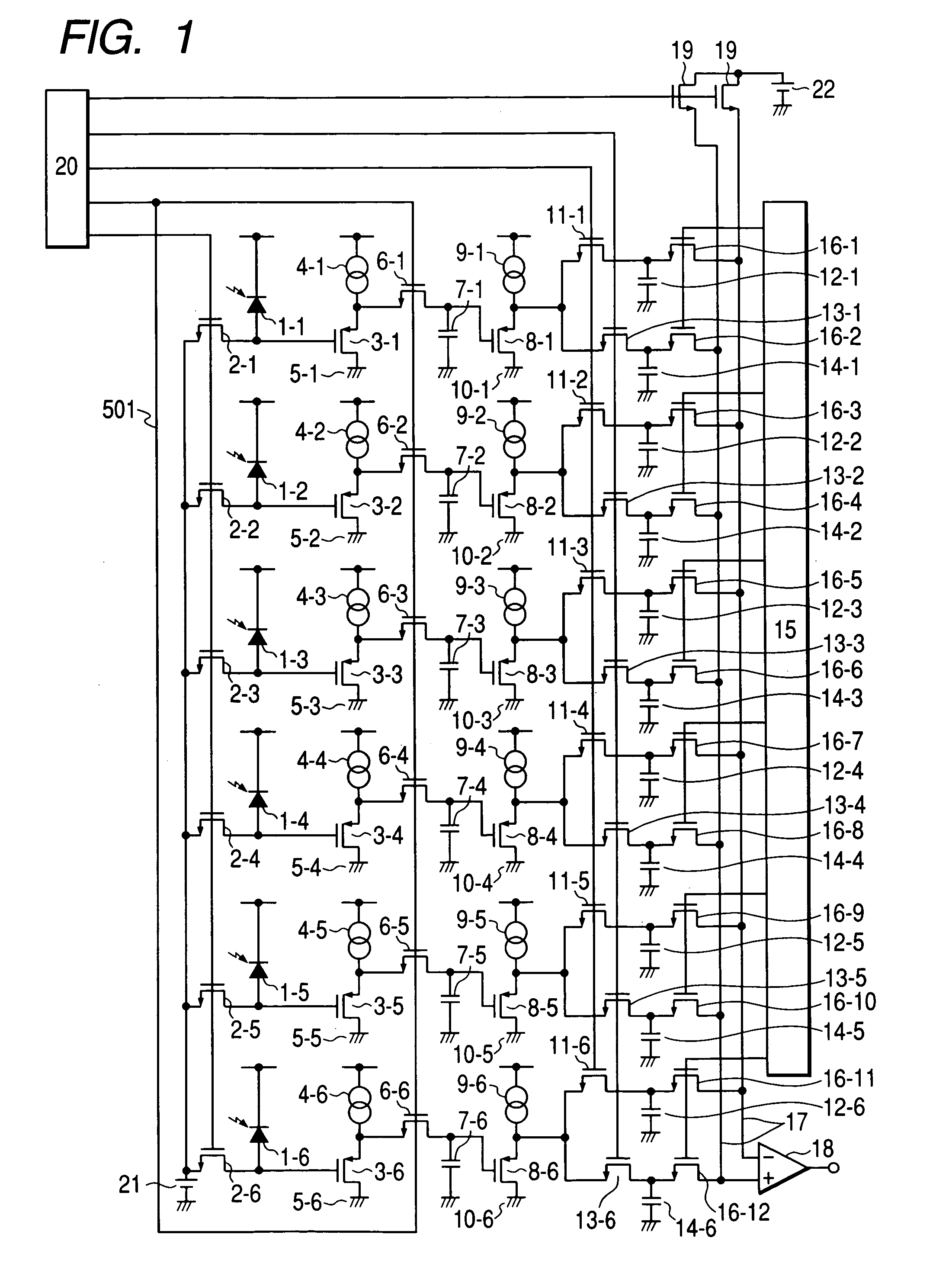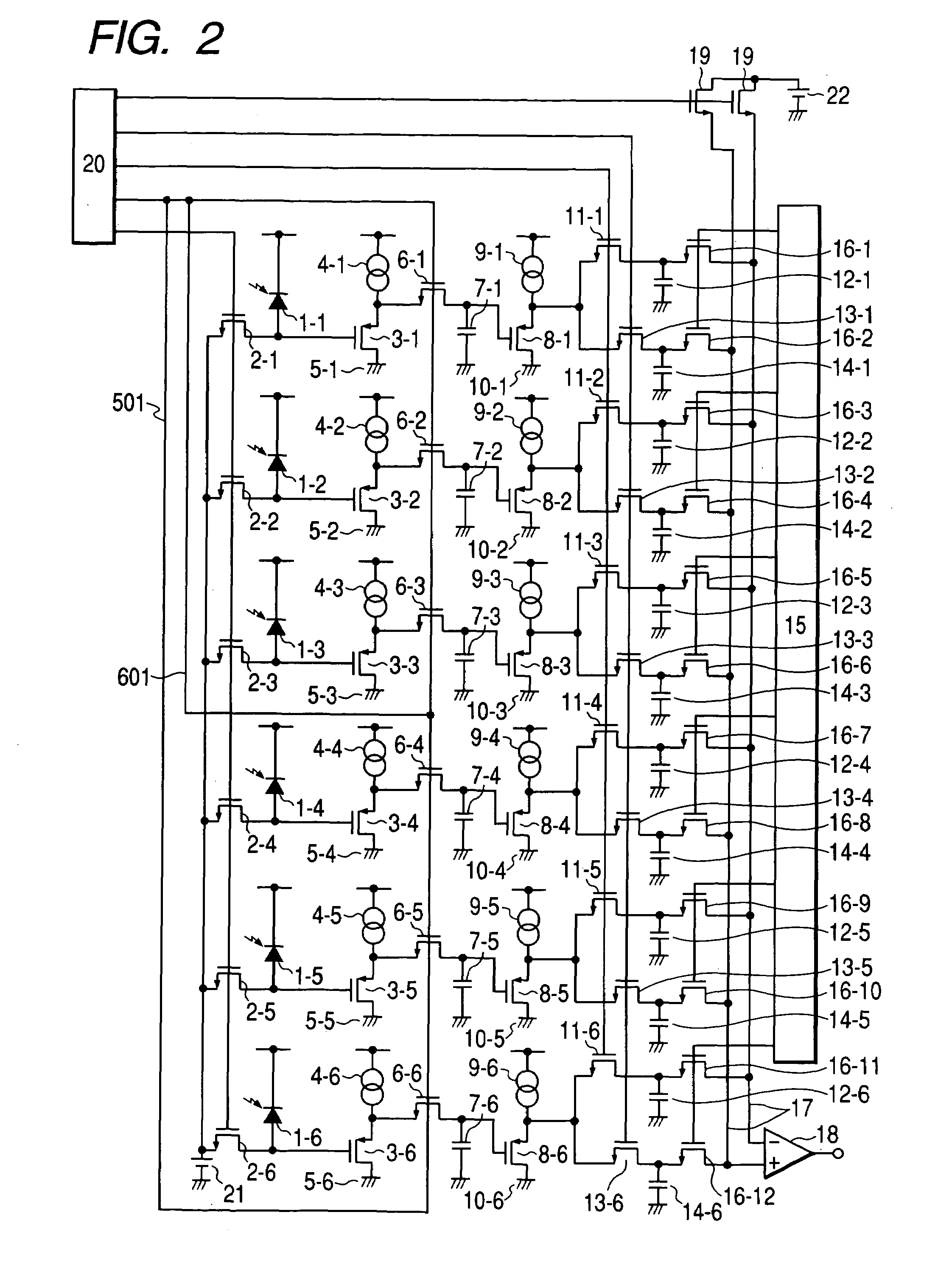Photoelectric conversion apparatus and contact-type image sensor
a conversion apparatus and contact-type technology, applied in the field of contact-type image sensors, can solve the problems of large deterioration of image quality, and inability to output negative values, so as to suppress the potential change of a signal storage capacitor, reduce the influence of a change, and improve the effect of image quality
- Summary
- Abstract
- Description
- Claims
- Application Information
AI Technical Summary
Benefits of technology
Problems solved by technology
Method used
Image
Examples
first embodiment
[0074]FIG. 1 is a schematic diagram showing a photoelectric conversion apparatus according to a first embodiment of the present invention.
[0075]In FIG. 1, the same members as those in FIG. 14 are denoted by like reference symbols. The photoelectric conversion apparatus of this embodiment is the same as a conventional one in that first transfer MOS transistors 6 are sequentially connected to a single control line, but is different therefrom in that the first transfer MOS transistors 6 are wired with not a given wiring extending from a logic circuit 20 on one side but the given wiring and an additional wiring 501 on both sides.
[0076]As shown in FIG. 1, although the additional wiring 501 involves a resistance component of the wiring itself on its path, there is no gate capacitance component of the MOS transistor involved in the original control line. Thus, a control signal can be transmitted up to a position where the wiring is connected to a first transfer MOS transistor 6-6 of FIG. 1...
second embodiment
[0079]FIG. 3 is a schematic diagram showing a photoelectric conversion apparatus according to a second embodiment of the present invention.
[0080]In FIG. 3, the same members as those in FIG. 14 are denoted by like reference symbols. The photoelectric conversion apparatus of this embodiment is the same as the first embodiment in that the first transfer MOS transistors 6 are wired with not a given wiring extending from the logic circuit 20 on one side but the given wiring and the additional wiring 501 on both sides, but is different therefrom in that the control signal is subjected to waveform shaping in a buffer circuit 701 immediately before being input to the first transfer MOS transistors 6 at the time of connecting therebetween.
[0081]With this configuration, it is possible to further reduce an influence of an RC time constant change slightly involved in the additional wiring (control line) 501, resulting in a larger improvement effect.
[0082]FIG. 4 shows another example of this emb...
third embodiment
[0085]FIG. 5 is a schematic diagram showing a photoelectric conversion apparatus according to a third embodiment of the present invention.
[0086]In FIG. 5, the same members as those in FIG. 14 are denoted by like reference symbols. In this embodiment, the first transfer MOS transistors 6 are wired with not a given wiring extending from the logic circuit 20 on one side but the given wiring and the additional wiring 501 on both sides. In addition, the control line connected to the first transfer MOS transistors 6 is divided into a control line 901 connected with preceding pixels (one group) and a control line 902 connected with succeeding pixels (the other group) somewhere in the path connecting between the first transfer MOS transistors 6.
[0087]The divided control lines 901 and 902 have terminal ends adjacent to each other on one sides opposite to sides connected to the logic circuit 20 in each group of the first transfer MOS transistors 6.
[0088]Further, although not shown, the divide...
PUM
 Login to View More
Login to View More Abstract
Description
Claims
Application Information
 Login to View More
Login to View More - R&D
- Intellectual Property
- Life Sciences
- Materials
- Tech Scout
- Unparalleled Data Quality
- Higher Quality Content
- 60% Fewer Hallucinations
Browse by: Latest US Patents, China's latest patents, Technical Efficacy Thesaurus, Application Domain, Technology Topic, Popular Technical Reports.
© 2025 PatSnap. All rights reserved.Legal|Privacy policy|Modern Slavery Act Transparency Statement|Sitemap|About US| Contact US: help@patsnap.com



